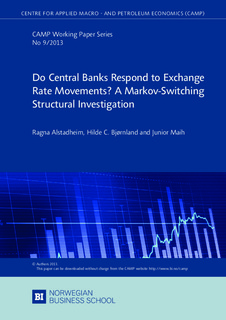Do Central Banks Respond to Exchange Rate Movements? A Markov-Switching Structural Investigation
Working paper
Permanent lenke
http://hdl.handle.net/11250/196695Utgivelsesdato
2013Metadata
Vis full innførselSamlinger
Sammendrag
Do central banks respond to exchange rate movements? According to Lubik
and Schorfheide (2007) who estimate structural general equilibrium models with
monetary policy rules, the answer is "Yes, some do". However, their analysis is
based on a sample with multiple regime changes, which may bias the results. We
revisit their original question using a Markov switching set up which explicitly allows for parameter changes. Fitting the data from four small open economies to
the model, we find that the size of policy responses, and the volatility of structural shocks, have not stayed constant during the sample period (1982-2011). In
particular, central banks in Sweden and the UK switched from a high response to
the exchange rate in the 1980s and early 1990s, to a low response some time after
in
ation targeting was implemented. Canada also observed a regime change, but
the decline in the exchange rate response was small relative to the increase in the
response to in
ation and output. Norway, on the other hand, did not observe a
shift in the policy response over time, as the central bank has stayed in a regime of
high exchange rate response prior and post implementing in
ation targeting.
